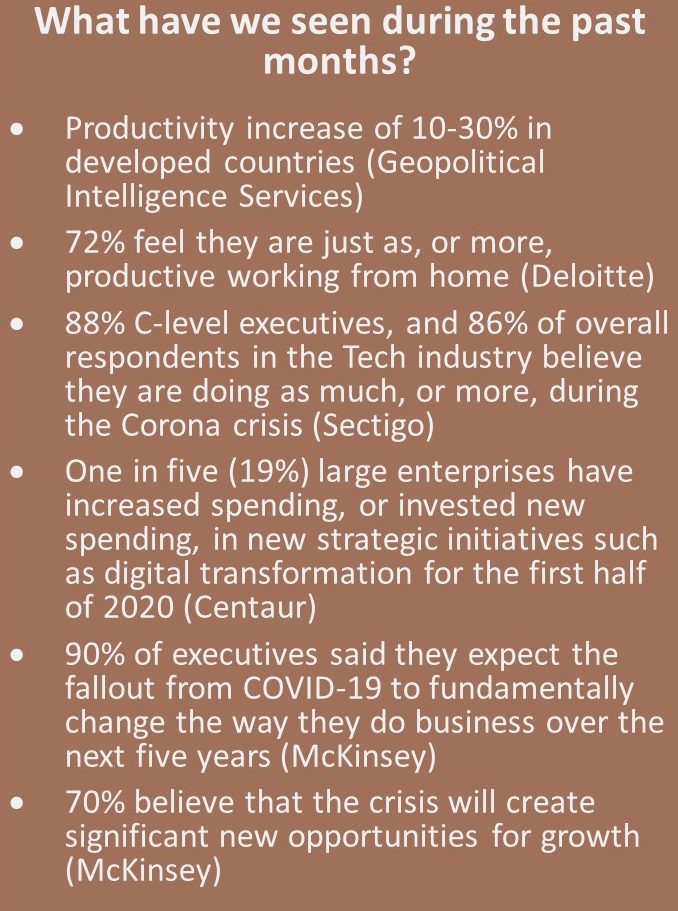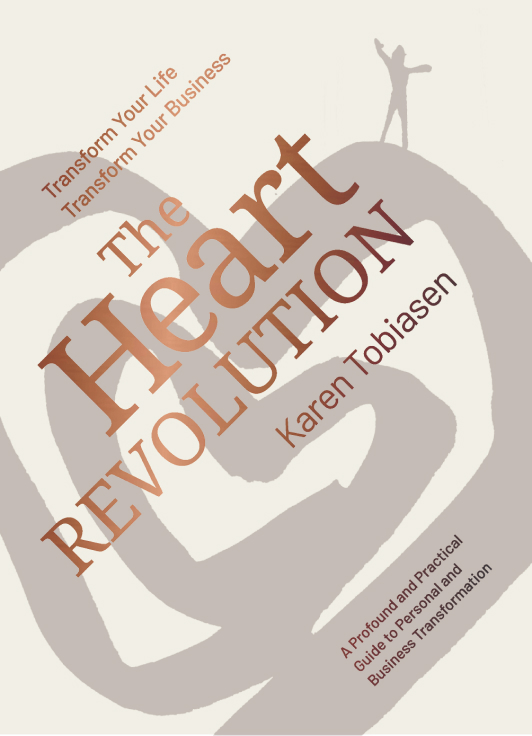
“I keep pushing myself and our team to think about how we use this inflection point to reimagine our potential together, as opposed to allowing our organization to just go back to the comfort of ‘let’s do what we’re doing,”
– Michael Fisher, CEO, Cincinnati Children’s Medical Center Hospital
Productivity is at a standstill. That’s been the headline conclusion in developed markets for years, where it’s increased by less than 1% annually for several years. But then, in the first two quarters of 2020, amid the Covid-19 crisis, it surged. Most developed economies witnessed a productivity increase of more than 10% – some even saw it rise above 20%!

During the same period, we’ve also seen companies deliver innovations that respond to people and market needs at unprecedented speed.
Even when accounting for the decrease in the size of the workforce and its effect on input volumes, this is a huge rise in productivity. It seems, when hit by a disruption, we respond with an accelerated ability to perform and transform – all at once.
So, the question is:
What did we believe before the crisis that held us back – and what new opportunities emerge when we reset?
Belief #1: People need to be managed to perform
While many companies are used to being able to observe the workforce on a day-to-day basis from the office, productivity and performance has suddenly become much more of a trust game. We’re in a situation where we’re evaluated less on the number of hours we spend at a desk, and more by the value we create.
It’s also become clear we don’t always have to be in an office to do our jobs. Deloitte research shows that – depending on the task – we can get things done more efficiently when we aren’t in a noisy office. Over 70% of respondents replied they are more or just as efficient when working from home. Only 1 in 4 think their productivity might suffer when working outside the office. So, is sustaining our performance post-COVID just a matter of adding more sound insulation walls in the office, or is it to continue being trusted to structure our own days?
Belief #2: Doing many things at once is needed to perform
The value of aligning around a common focus has never been clearer. With a clear goal of enabling our colleagues to collaborate and connect virtually meant we all mobilized in one direction, pooling our collective minds together to find the right solutions. And we got the job done. Because there was a priority for everyone to rally around, distractions fell to the side and we all focused on what was needed for the business to succeed.
The same can be said about the global response to developing a vaccine or producing the hygiene and protective equipment needed. United to get us through the pandemic with as few casualties as possible, companies and organizations paused other activities to channel their energy into supporting that one goal. Imagine how much we could get done if we approached our priorities with the same focus and effort. How increased focus could increase performance: because by deciding to act and move in a clear direction, we can move with greater speed and urgency to complete it – and then be ready to take on the next goal. What’s the next task your organization will put an urgent focus on?
Belief #3: Performing change takes time
And on the other side of focus, also lies truths about time. We’ve inherited a belief that change programs take time, and that healthy project planning includes lots of buffer because it’s better to deliver ahead of time than risk being delayed – often ignoring Parkinson’s Law that “work expands so as to fill the time available for its completion”. And yet in this pandemic, we saw the implementation and adoption of digital devices and collaboration tools – activities that were planned to take months – be done in hours and days. Doing a job properly takes time, but have we been building too much slack into our processes because of how we assess performance?
COVID-19 gives us a shared burning platform. It makes us reconsider many of the rules and regulations that have been in place so long we barely remember where they came from or why we had in the first place. A startup can now pivot to online healthcare – a move that would’ve been impossible before due to privacy and doctor-patient care regulations. Simple documents that had to be printed, signed and mailed, can now be signed online – shortening handling time from days or weeks, to hours.
When we are willing to take a fresh look at our organizations, we may see that we ourselves have made decisions that hold us back with cumbersome processes, bureaucratic practices, and an overly-risk-averse mindset. What could happen for our performance if we spent less energy blaming our inability to meet deadlines or deliver work on someone or something else – and instead consider what part we play?
Belief #4: Performance will decline because we are not meeting face-to-face
In the Deloitte study, the lack of personal interactions with colleagues and clients was a big concern. We fear losing human connection and the benefits that come with it. We’re fortunate to have the tools that help meet a lot of our connection needs – with video calls, real-time collaboration, etc. But we still seek something that connects us beyond surface level, and the need for a clear purpose in an organization is more apparent than ever. When the glue that keeps an organization and teams together is less strengthened by the day-to-day interactions and talks around the coffee machine, we rely on being able to understand our purpose as individuals and teams, and having the open communication to forge that bond.
A shared purpose is also important for our ability to innovate. Studies have found face-to-face collaboration is a key ingredient to being able to come up with the next big idea and innovation. So when that is less of a possibility, then having a common goal, understanding and vocabulary can be the next best thing to forming the connections that enhance our innovative side. So, can we meet our performance needs if we can connect with colleagues over a more profound, shared purpose that exits beyond physical walls?
What can we learn?
COVID-19 has shown us that we can indeed thrive and increase performance even when our usual ways of working are challenged, and we are prompted by the call for transformation to leave behind what we’re used to. The people and organizations that do well are the ones that have the transformational capacity to adapt. As the World Economic Forum puts it:
“The intense innovation activity ignited by the global pandemic shows that some elephants can dance when they must.”


